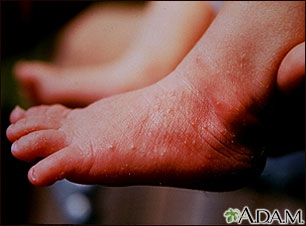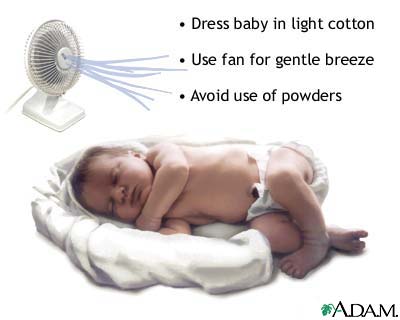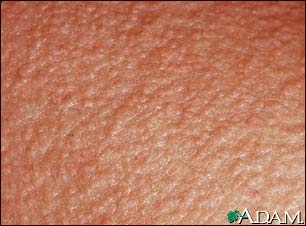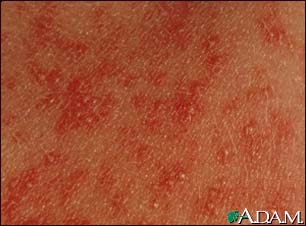Health Library
Rash - child under 2 years
Baby rash; Miliaria; Prickly heat
A rash is a change in the color or texture of the skin. A skin rash can be:
- Bumpy
- Flat
- Red, skin-colored, or slightly lighter or darker than skin color
- Scaly
Images




I Would Like to Learn About:
Considerations
Most bumps and blotches on a newborn baby are harmless and clear up by themselves.
The most common skin problem in infants is diaper rash. Diaper rash is an irritation of the skin caused by dampness, urine, or feces. Most babies who wear diapers will have some type of diaper rash at some point.
Other skin disorders can cause rashes. These are most often not serious unless they occur with other symptoms.
Causes
Causes may include:
- Diaper rash (rash in the diaper area) is a skin irritation caused by long-term dampness and by urine and feces touching the skin.
- Yeast diaper rash is caused by a type of yeast called Candida, which also causes thrush in the mouth. The rash looks different from a regular diaper rash. It is very red, and there are usually small red bumps on the outer edges of the rash. This rash requires treatment with medicine.
- Heat rash, or prickly heat, is caused by the blockage of the pores that lead to the sweat glands. It is most common in very young children but can occur at any age. It is more common in hot and humid weather. The sweat is held within the skin and forms little red bumps or occasionally small blisters.
- Erythema toxicum can cause flat red splotches (usually with a white, pimple-like bump in the middle) that appear in up to one half of all babies. This rash rarely appears after 5 days of age, and most often disappears in 7 to 14 days. It is nothing to worry about.
- Baby acne is caused by exposure to the mother's hormones. Red bumps, sometimes with white dots in the center, may be seen on a newborn's face. Acne most often occurs between 2 and 4 weeks of age, but may appear up to 4 months after birth and can last for 12 to 18 months.
- Cradle cap (seborrheic dermatitis) causes greasy, scaling, crusty patches on the scalp that appear in a baby's first 3 months. It most often goes away by itself, but some cases may require treatment with medicine.
- Eczema is a condition of the skin in which areas are dry, scaly, red (or darker than normal skin color), and itchy. When it goes on for a long time the areas become thickened. It is often associated with asthma and allergies, although it can often occur without either of these. Eczema often runs in families.
- Hives are red welts that often seem to move around on the body. For example, if you drew a circle to mark one of the welts, a few hours later that circle would not have a welt in it, but there may be welts on other parts of the body. They differ in size and shape. Hives may last for a few weeks. The cause is often uncertain.
Home Care
DIAPER RASHES
Keep the skin dry. Change wet diapers as quickly as possible. Allow the baby's skin to air dry as long as is practical. Launder cloth diapers in mild soap and rinse well. Avoid using plastic pants. Avoid irritating wipes (especially those containing alcohol) when cleaning the infant.
Ointments or creams may help reduce friction and protect the baby's skin from irritation. Powders such as cornstarch or talc should be used cautiously, as they can be inhaled by the infant and may cause lung injury.
If your baby has a yeast diaper rash, the health care provider will prescribe an antifungal cream to treat it.
OTHER RASHES
Heat rash or prickly heat is best treated by providing a cooler and less humid environment for the child.
Powders are unlikely to help treat heat rash and should be stored out of reach of the infant to prevent accidental inhalation. Avoid ointments and creams because they tend to keep the skin warmer and block the pores.
Erythema toxicum is normal in newborn babies and will go away on its own in a few days. You do not need to do anything for it.
White or clear milia/miliaria will go away on their own. You do not need to do anything for it.
For hives, talk with your provider to try to find the cause. Some causes require prescription medicines. Antihistamines may help stop the itching.
BABY ACNE
Normal washing is all that is necessary to treat baby acne most of the time. Use plain water or mild baby soap and only bathe your baby every 2 to 3 days. Avoid acne medicines used by adolescents and adults.
CRADLE CAP
For cradle cap, wash the hair or scalp with water or a mild baby shampoo. Use a brush to remove the flakes of dry skin. If this cannot be removed easily, apply an oil to the scalp to soften it. Cradle cap most often disappears by 18 months. If it does not disappear, it becomes infected, or if it is resistant to treatments, consult your provider.
ECZEMA
For skin problems caused by eczema, the keys to reducing rash are to reduce scratching and keep the skin moisturized.
- Keep the baby's fingernails short and consider putting soft gloves on the child at night to minimize scratching.
- Drying soaps and anything that has caused irritation in the past (including foods) should be avoided.
- Apply a moisturizing cream or ointment immediately after baths to avoid drying.
- Hot or long baths, or bubble baths, may be more drying and should be avoided.
- Loose, cotton clothing will help absorb perspiration.
- Consult a provider if these measures do not control the eczema. Your child may need prescription medicines for the eczema or if the skin begins to appear infected.
While the majority of children with eczema will outgrow it, many will have sensitive skin as adults.
When to Contact a Medical Professional
Contact your child's provider if your child has:
- A fever or other unexplained symptoms associated with the rash
- Any areas that look wet, oozing, or red, which are signs of infection
- A rash that extends beyond the diaper area
- A rash that is worse in the skin creases
- A rash, spots, blister, or discoloration and is younger than 3 months
- Blisters
- No improvement after 3 days of home treatment
- Significant scratching
What to Expect at Your Office Visit
The provider will perform a physical exam. The baby's skin will be thoroughly examined to determine the extent and type of the rash. Bring a list of all the products used on the child's skin.
You may be asked questions such as:
- When did the rash start?
- Did symptoms begin at birth? Did they occur after fever was relieved?
- Is the rash related to skin injury, bathing, or exposure to sunlight or cold?
- What does the rash look like?
- Where on the body does the rash occur? Has it spread to other areas?
- What other symptoms are also present?
- What type of soaps and detergents do you use?
- Do you put anything on the skin (creams, lotions, oils, perfumes)?
- Is your child taking any medicines? How long has the child taken them?
- Has your child recently eaten any new foods?
- Has your child been in contact with grasses/weeds/trees recently?
- Has your child recently been sick?
- Do any skin problems run in your family? Does your child or anyone in your family have allergies?
Tests are seldom required but may include the following:
- Allergy skin tests
- Blood studies (such as CBC, blood differential)
- Microscopic examination of a sample of the affected skin
Depending on the cause of the rash, antihistamines may be recommended to decrease itching. Antibiotics may be prescribed if there is a bacterial infection.
The provider may prescribe a cream for diaper rash caused by yeast. If the rash is severe and not caused by yeast, a corticosteroid cream may be recommended.
For eczema, the provider may prescribe ointments or corticosteroid drugs to decrease inflammation.
Related Information
References
DiBiagio JR, Lloyd CM. Dermatology. In: Kleinman K, Mcdaniel L, Molloy M, eds. The Harriet Lane Handbook. 22nd ed. Philadelphia, PA: Elsevier; 2021:chap 8.
Gehris RP. Dermatology. In: Zitelli BJ, McIntire SC, Nowalk AJ, eds. Zitelli and Davis' Atlas of Pediatric Physical Diagnosis. 7th ed. Philadelphia, PA: Elsevier; 2018:chap 8.
Valeyrie-Allanore L, Obeid G, Revuz J. Drug reactions. In: Bolognia JL, Schaffer JV, Cerroni L, eds. Dermatology. 4th ed. Philadelphia, PA: Elsevier Limited; 2018:chap 21.
BACK TO TOPReview Date: 1/24/2023
Reviewed By: Neil K. Kaneshiro, MD, MHA, Clinical Professor of Pediatrics, University of Washington School of Medicine, Seattle, WA. Also reviewed by David Zieve, MD, MHA, Medical Director, Brenda Conaway, Editorial Director, and the A.D.A.M. Editorial team.
 | A.D.A.M., Inc. is accredited by URAC, for Health Content Provider (www.urac.org). URAC's accreditation program is an independent audit to verify that A.D.A.M. follows rigorous standards of quality and accountability. A.D.A.M. is among the first to achieve this important distinction for online health information and services. Learn more about A.D.A.M.'s editorial policy, editorial process and privacy policy. A.D.A.M. is also a founding member of Hi-Ethics. This site complies with the HONcode standard for trustworthy health information: verify here. |
The information provided herein should not be used during any medical emergency or for the diagnosis or treatment of any medical condition. A licensed medical professional should be consulted for diagnosis and treatment of any and all medical conditions. Links to other sites are provided for information only -- they do not constitute endorsements of those other sites. © 1997- 2023 A.D.A.M., a business unit of Ebix, Inc. Any duplication or distribution of the information contained herein is strictly prohibited.
